Why I'm Ditching Windows and Adobe
Like a lot of people, I've found myself fed up with the shady business practices of Adobe and the privacy nightmare of Microsoft Windows. I decided that it's time to do something about it and move to a completely free and open-source photography workflow.

At this point, I've been practicing photography in some form for over a decade. For essentially that entire time, I've based my entire workflow around the Adobe Creative Cloud Suite running on a Microsoft Windows PC. In many ways, this workflow was great, but in other ways, I've always had issues with it.
Despite these issues, however, I would just grit my teeth and deal with the problems. As the years marched by, though, the frustrations only grew. Frustration after frustration, I would continue to lament the growing number of issues. I would subject my fiancée to epic rants about how awful Windows is and how Adobe is a horrendous company. But then I would return to gritting my teeth and continue using them.
No more! It's finally time to take a stand and make a drastic change to my entire workflow. I've long threatened to move to a completely free and open-source workflow, but now is the time to finally make it happen.
How Did I Get Here?
Before I get into how I'm going to be making these changes, I think it's essential to take some time to understand how I've gotten to this point. After all, completely upending my entire workflow and moving to something new is no small feat.
The Problem with Adobe
I'll start by talking about my problems with Adobe, as this is actually the shorter of my rants.
In all honesty, there's no denying that Adobe makes some overall amazing creative tools. They're an industry standard for a reason! The power that Lightroom, Photoshop, and Premiere Pro have brought to my work is insane. There is no doubt plenty of pros to sticking with Adobe tools, but, increasingly, the cons outweigh these pros for me.
Annoyance #1: Forced AI Features
It seems that there isn't a single company that isn't trying to shove new AI solutions down its customers' throats these days. Adobe is certainly no exception to this. While AI can be legitimately useful, I fully believe that we're currently witnessing an AI bubble that's bound to pop (similar to when the dot-com bubble popped at the turn of the century).
Now, I will admit that some of the AI features that Adobe has introduced can be legitimately useful. For example, using generative AI to enhance object removal works great. I personally try to take a minimal approach to photo editing, though. As such, I really don't want or need most of these AI features. And I certainly don't want any features that generate the work for me.
Annoyance #2: Shady Business Practices
Truth be told, I'd be willing to deal with the needless proliferation of A.I. in the Creative Cloud products (to a point). I'm much less willing to deal with Adobe's shady business practices, however. These really boil down to two distinct categories for me:
- It's deceptively difficult to cancel your subscription. Not only do I feel that it's overly complex to cancel your subscription, but Adobe is notorious for trying to charge you a steep cancellation fee for leaving. While they do technically state that you're agreeing to an annual contract, billed monthly, when you subscribe to their Creative Cloud offerings, it's still not very obvious (fun fact: you can avoid this fee by switching your plan to a different one and then immediately canceling it). And it's not just me who finds this shady. In 2014, the FTC initiated a lawsuit against Adobe over these practices.
- A horrendous Privacy Policy. On top of their other anti-consumer practices, Adobe has a privacy policy that's as horrendous as any other big tech company. Like any of the other tech giants, they collect a wealth of telemetry data on their users, perform scanning of your files in the background, and try to force you into their cloud offerings. On top of all of this, in 2024, Adobe updated its terms of service to indicate that it could access your content "through automated and manual methods". Many users interpreted this as Adobe saying they'd use your work to train their AI. Shortly after, Adobe released a statement stating that this was not the case. The wording of the privacy policy is opaque enough, however, that many, including myself, do not believe this. Even if it's true now, it may not hold true in the future.
Annoyance #3: The Subscription Cost
The last big annoyance with Adobe that I'll mention here is the cost of subscribing to the Creative Cloud. At the time of writing this post, the photography plan that includes Lightroom and Photoshop is priced at $19.99 per month. The "Creative Cloud Standard" plan, which gives you "basic" access to all of the Creative Cloud applications, is $54.99 per month, and the "Creative Cloud Pro" plan, which is basically the standard plan with more AI credits and such, is $69.99 per month. That results in the following annual cost:
- Photography Plan: $239.88
- Creative Cloud Standard Plan: $659.88
- Creative Cloud Pro Plan: $839.88
It's also worth mentioning that you can save a little bit on the Standard and Pro plans by paying the annual fee upfront (this does not appear to be an option for the photography plan):
- Creative Cloud Standard Plan: $599.88
- Creative Cloud Pro Plan: $7779.00
It's also worth noting that these are the recently updated, increased prices. Their reasoning for increasing the pricing? Well, the forced AI "value add", of course!
Even if I simply dropped using Premiere Pro, After Effects, and Illustrator to only subscribe to the photography plan, that's still $240 a year, an unacceptable amount for me, especially when you consider that this is not my primary source of income.
The Problem with Microsoft and Windows
Oh boy, was that a lot of ranting about Adobe, but we're not done with the ranting just yet! Let's talk about Microsoft and, more specifically, Microsoft Windows.
Truth be told, I've never been a fan of Windows. I've largely kept it around because I have my own problems with Apple and have, until recently, had a hard requirement on being able to run the Adobe Suite of tools.
For the longest time, though, Windows has largely been... fine for me. Not great. Not good. But fine (ignoring the usability and stability nightmare that was Windows 8). Windows 10 had its own set of annoyances, but continued the general trend of things being fine.
The release of Windows 11 marked a turning point for me. This is a topic that I could write a whole series of posts on, but I'll do my best to keep this concise.
Microsoft Windows is Anti-consumer
Most of my complaints about Windows 11 are that the entire experience is anti-consumer. You'd think that Microsoft owns my computer given the level of control they try to exert over my computing experience.
There are honestly far too many examples of this for me to cover them all here, but I'll try to highlight some of what are, in my opinion, the biggest offenders.
Insistence on Online Accounts
Microsoft tries its best to strong-arm you into using an online account with Windows 11 instead of a local-only user account. By default, you don't even get the option to create a local-only account when you install Windows 11 anymore. There are workarounds for this, but Microsoft is constantly making them more difficult than it should be, and I have no doubt that they'll eventually make it effectively impossible at some point in the future.
Even when you do manage to create a local account, they will constantly nag you to connect your Microsoft account and migrate to an online account for Windows. Just as an example, look at the main page of the settings application:
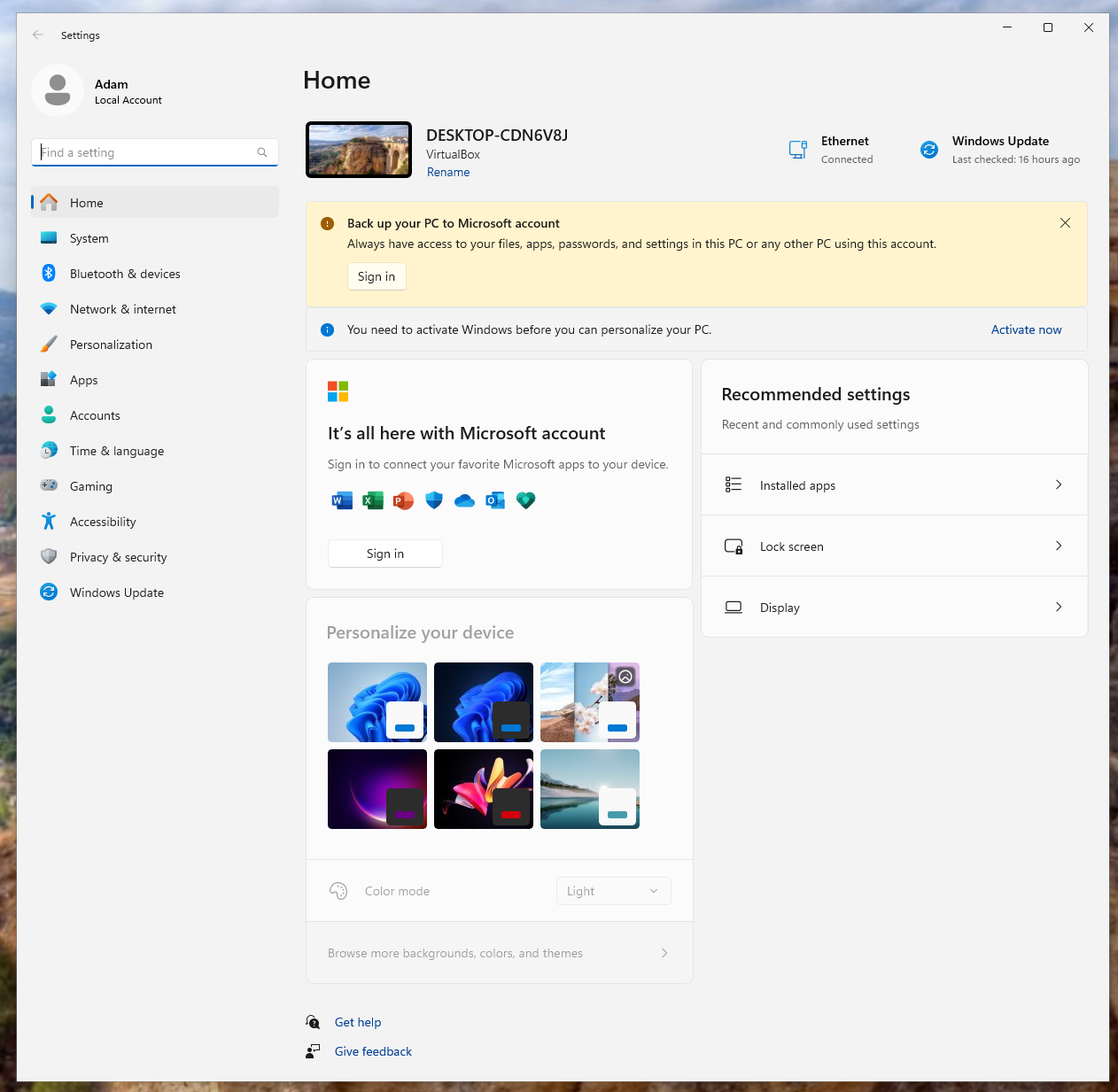
Constant Advertising and Forced App Installs
Windows 11 is an advertising machine for Microsoft. When you install the operating system, it will present you with several upsells for things like Microsoft 365 and Xbox Live. If you have an online account, you'll see ads for Microsoft services in the settings application. They'll place ads in the start menu and show notifications, trying to upsell you Microsoft services. They associate a unique advertising ID with your account to better track you online and serve more relevant ads to you. The list goes on and on.
On top of this, and in a similar vein, Microsoft is constantly forcing unwanted applications onto your computer. Just take a look at the start menu on a fresh install of Windows 11:
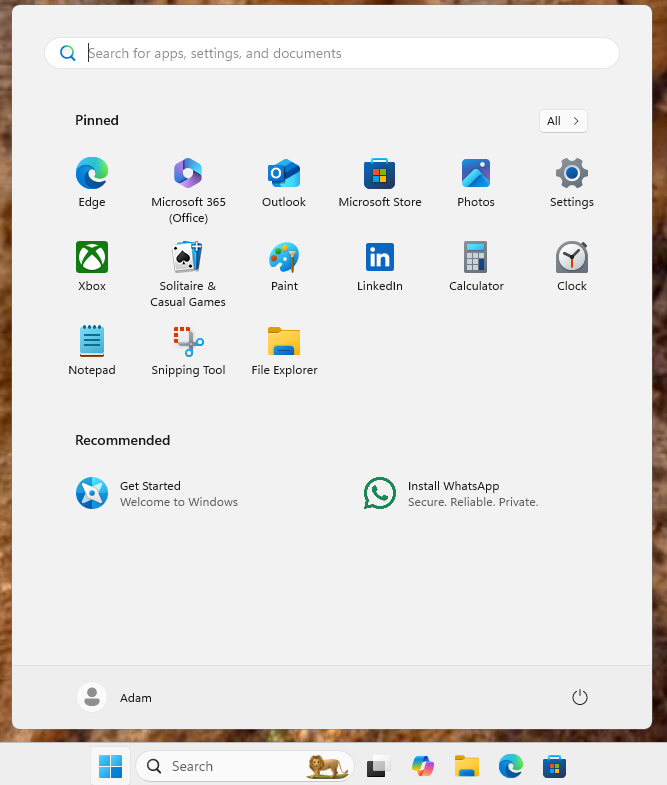
Outlook. Microsoft 365. LinkedIn. Xbox. These are all applications that Microsoft pre-installs on your computer. In the past, it has even included non-Microsoft apps like TikTok. And, sure, you can uninstall these pretty easily (though I'd argue you shouldn't have to), but they'll likely re-install them the next time an update is installed.
Oh, and let's not forget that Microsoft, like all of the other big tech companies, is shoehorning useless AI features into its operating system.
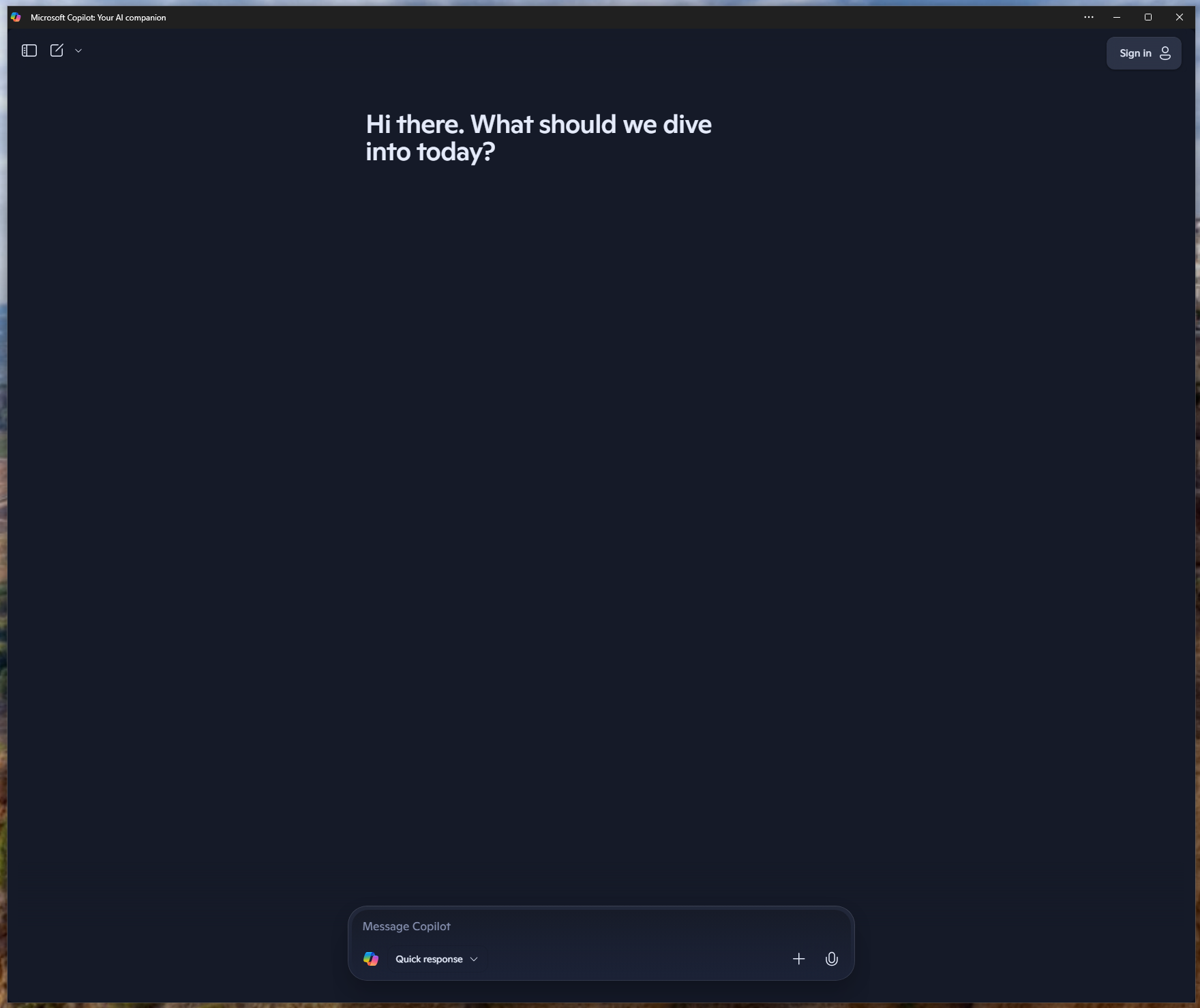
It's not just Microsoft Copilot I'm talking about here. Now, apps like Microsoft Paint and Notepad insist on presenting AI features that, in my opinion, add no value. As if this isn't bad enough, you should check out Microsoft's vision for the future of Windows.
A Privacy Nightmare
I don't mention it much here, but Photography is not how I pay the bills. By day, I am a software engineer and security researcher. As such, I take my privacy and security extremely seriously. Windows 11 is such a privacy nightmare that I struggle to consider it anything less than spyware.
Windows 11 tracks virtually everything you do. Your location, your browsing habits, what you search for, what kind of files you save, what apps you open when, the list goes on and on. You're always under the watchful eye of Microsoft when you're using modern Windows.
Sure, you can supposedly disable some of this tracking in the settings, but they have a habit of being re-enabled when you update, and it's impossible to disable everything in this way. There are also scripts you can run to try to disable the tracking features, but this is a constant cat-and-mouse game, and it's likely that there's still some amount of tracking occurring.
There's no better indication of how little Microsoft values the privacy of its customers than Microsoft Recall, but I'll leave you to research that nightmare on your own. Sure, it's disabled by default now, but it shouldn't even be something that exists in the operating system.
You Pay for this Abuse
Everything I've mentioned up until this point is bad enough. There's even a term that describes the phenomenon of a tech product becoming increasingly hostile to its users over time: enshittification.
But you know what really rubs salt in the wound? You still have to pay $139 for a legitimate Windows 11 Home license from Microsoft (or $199.99 for a Windows 11 Pro license). That's right, you're paying for the "right" to be, in my strong opinion, exploited by Microsoft.
I'd expect this level of user hostility and enshittification from free services, such as Google or Facebook, but not from a paid product. And the fact that it's the operating system itself committing these sins is even more egregious in my book.
So, where do I go from Here?
Phew, that sure was a lot of ranting! And I even kept it brief! With all of this complaining out of the way, however, you might be left wondering where I've ended up. Let's start with the operating system.
The Switch to Linux
For the uninitiated, there are actually quite a few options of operating systems outside the two most common: Windows and macOS. One of the most compelling alternatives is Linux.
Simply put, Linux is a free and open-source operating system kernel (that is to say, Linux provides the core of an operating system). There are a lot of different versions of Linux, called distributions, that you can choose from to run on your computer. Some popular ones for beginners include Ubuntu and Linux Mint, though there are hundreds of distributions out there. Almost all of these Linux distributions are entirely free to use and open-source.
Don't let the fact that it's free lead you to believe that Linux is somehow inferior to the commercial offerings, however. I can assure you that it's extremely powerful, and modern versions run great on the desktop. In fact, even if you don't realize it, you use Linux every single day. Most of the world's servers run on Linux. This means pretty much any website you interact with is likely running on top of Linux. Additionally, if you're an Android user, you're also using Linux, as Android is built on top of it.
I've actually been a huge advocate for Linux and open-source since I was a teenager, and I use it in every aspect of my life except for my main desktop, where I do my creative work. The reason being that I previously had a hard requirement on the Adobe Suite. Now that I've removed that dependency on Adobe, I'm now happy to say that I run Linux everywhere (and it works great)!
An Open-Source Photography Workflow
This all begs the question of how I'm removing my dependence on Adobe and moving to a completely free and open-source photography workflow. In all honesty, this question is a bit harder to answer and is still a work in progress. I certainly don't have it all figured out yet.
For now, my workflow contains the following pieces:
Darktable to Replace Adobe Lightroom
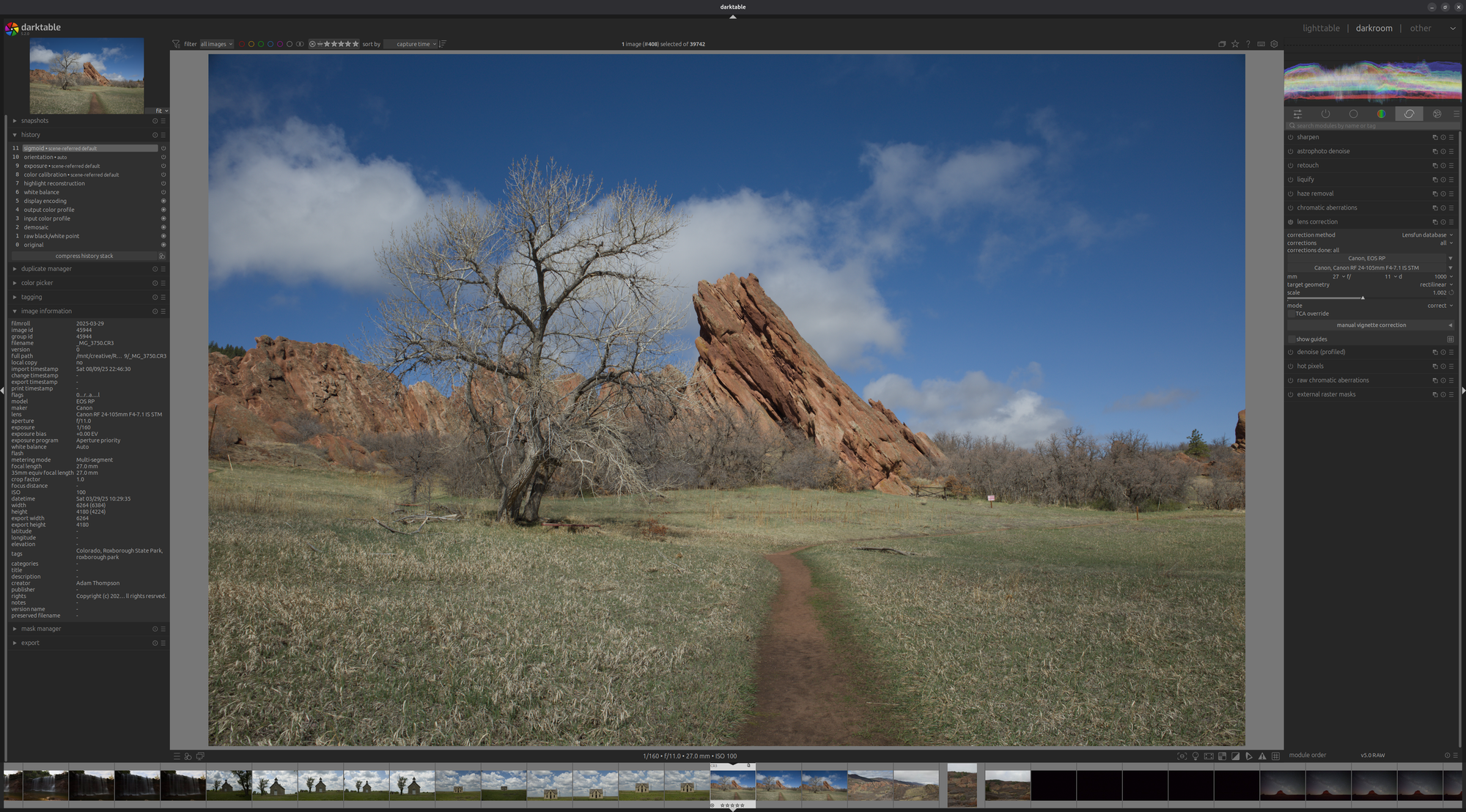
By far the most powerful, open-source replacement for Lightroom is Darktable. It provides a library module that's similar to Lightroom's and has extremely powerful editing features. It's also available for Linux, Windows, and Mac, so you have the option to give it a spin without diving headfirst into Linux.
The biggest problem with Darktable is that it's far more complicated than Lightroom. Figuring out how to use this software is definitely a learning curve! Part of this is because the developers of Darktable expose just about every option you could ever imagine to you as a user. This makes the software insanely powerful, but a bit intimidating at first glance.
With all of that said, the complexity of all the added dials somehow appeals to my engineering-focused brain. I can certainly acknowledge that this isn't everyone's speed, however.
I also intend to take a look at ART, which is a fork of another project called RawTherapee, but I don't have too much to say about either of those at this time.
GIMP to Replace Photoshop
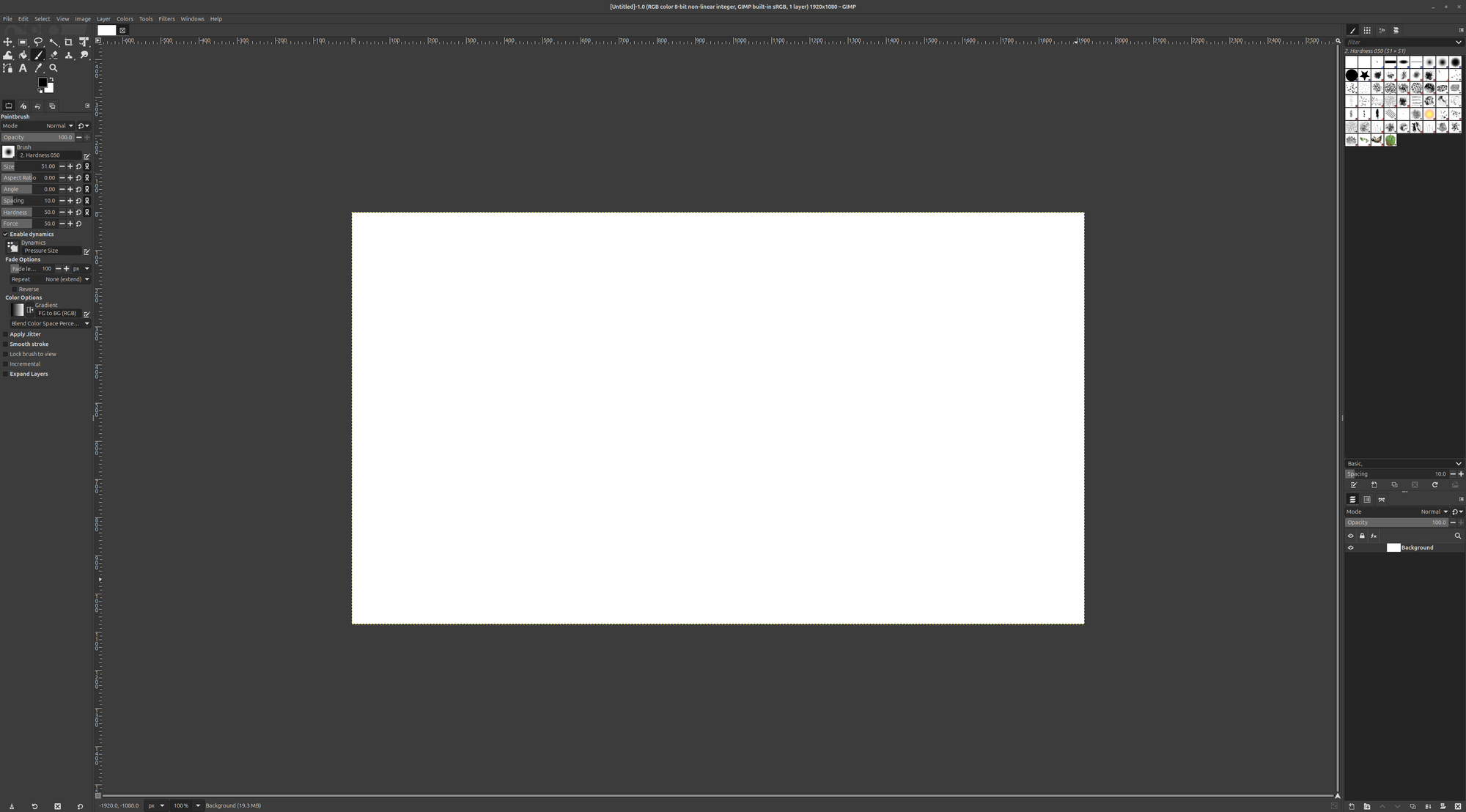
My alternative to Photoshop so far is the GNU Image Manipulation Program, or just GIMP for short. Now, I'll be the first to admit that GIMP is nowhere near as powerful as Photoshop, and it's simply not going to cut it for many workflows. As I mentioned earlier, however, I tend to take as minimalistic an approach to photo editing as possible, so I think this should fit my needs just fine.
Similar to Darktable, GIMP is available for Linux, Windows, and macOS.
Inkscape as an Alternative to Illustrator
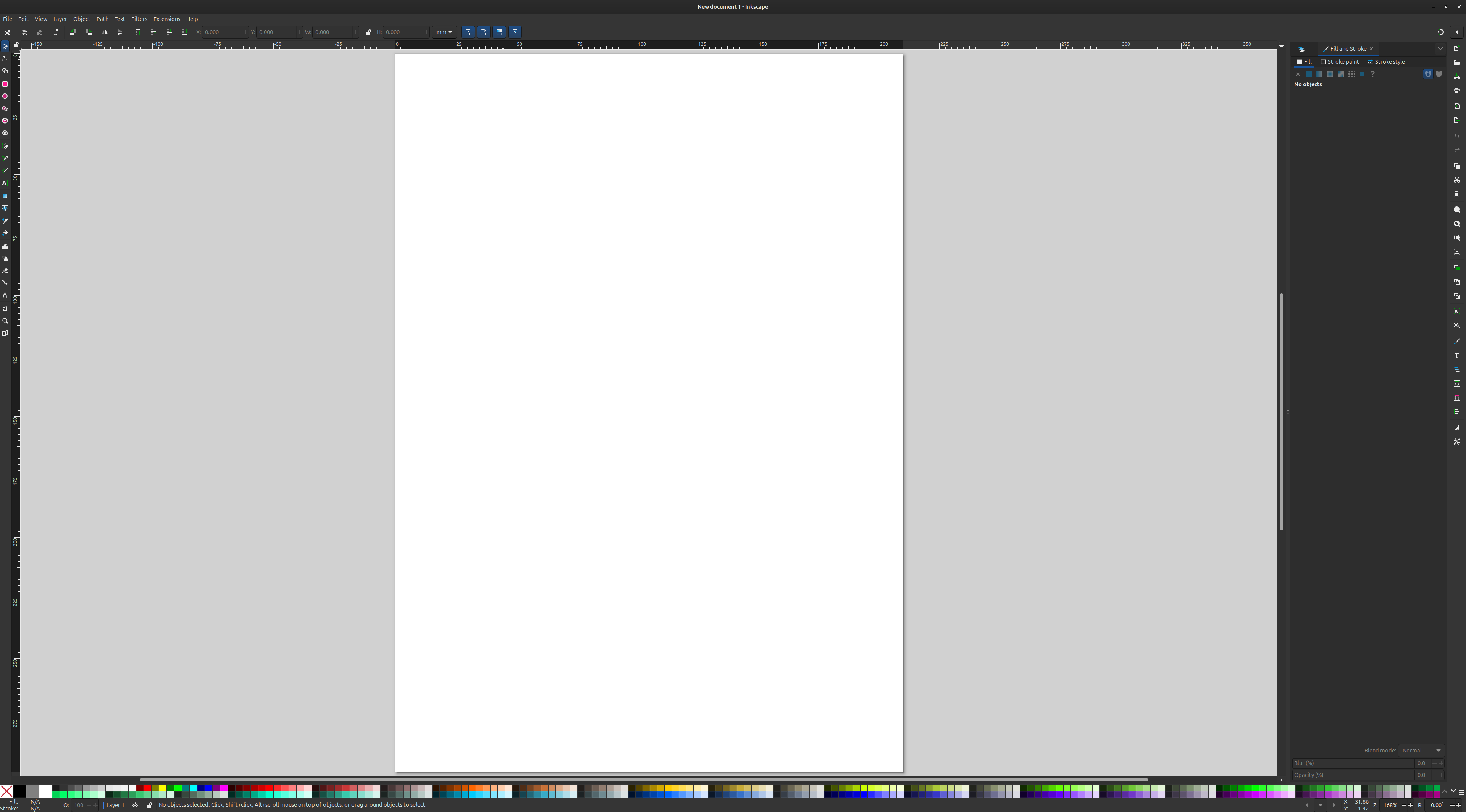
For those times when I need to work with vector graphics, I'm using Inkscape as a replacement for Adobe Illustrator. I honestly can not praise Inkscape enough. Not only is it free and open-source, but it's also a fantastic piece of software. I actually find it to be better than Illustrator (at least for my use case).
Kdenlive and Davinci Resolve as an Alternative for Premiere Pro
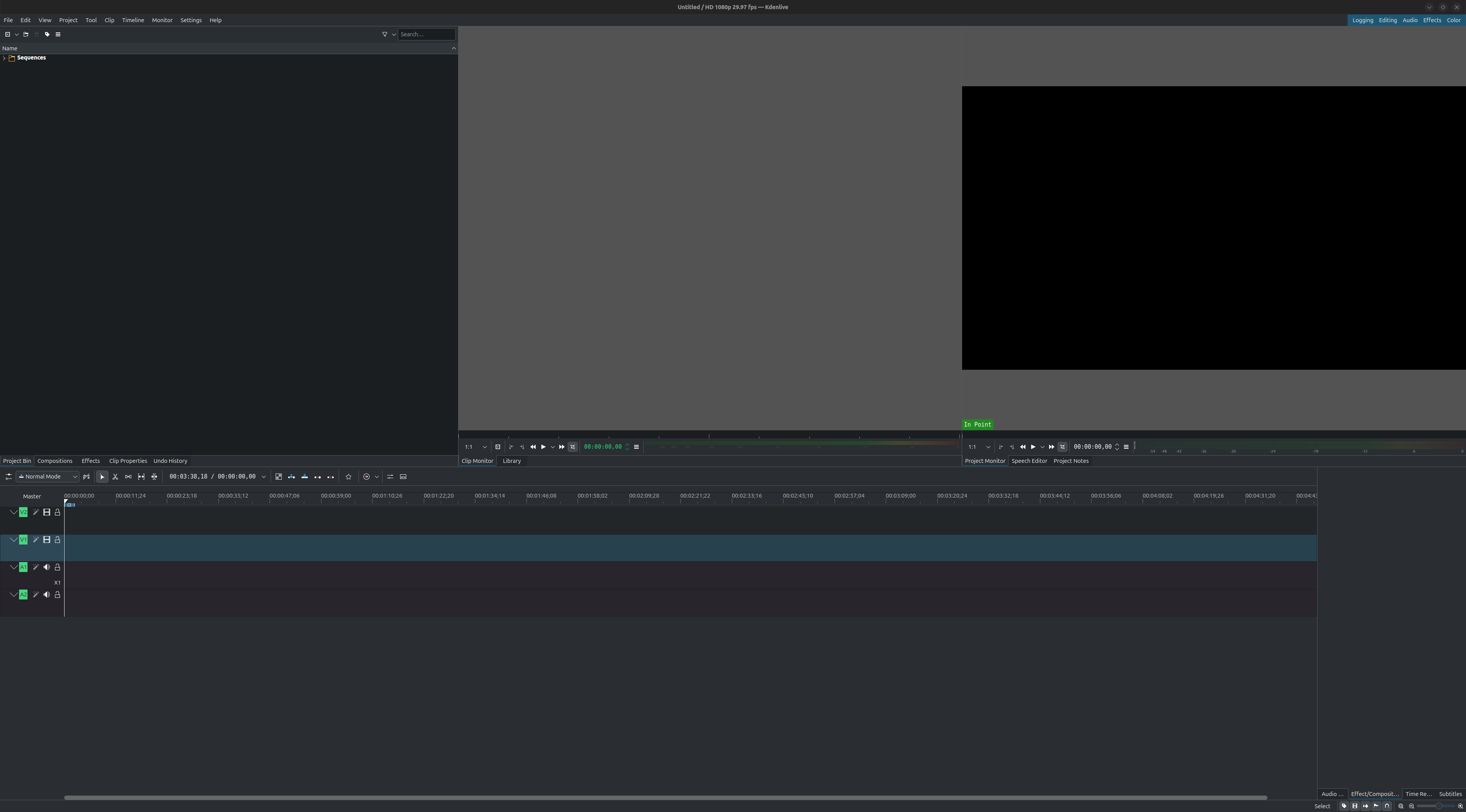
The last creative area that I needed to find alternatives for is video editing. This actually turned out to be the easiest option since Davinci Resolve runs on Linux (with a few caveats, such as a lack of support for MPEG-4 encoded videos).
For now, however, I intend to give Kdenlive a go for my video editing needs as I'd like as much of my workflow as possible to be based on free and open-source software.
As you've probably guessed, Kdenlive is an open-source non-linear video editor. It supports all of the basic functionality that you'd expect to find in a modern video editor. With that said, it is not even in the same universe in terms of how powerful an application like Davinci Resolve is.
Still, my video edits are typically pretty simple, so I'm hoping that Kdenlive will fit the bill. Should it not, however, I can always use Davinci Resolve under Linux!
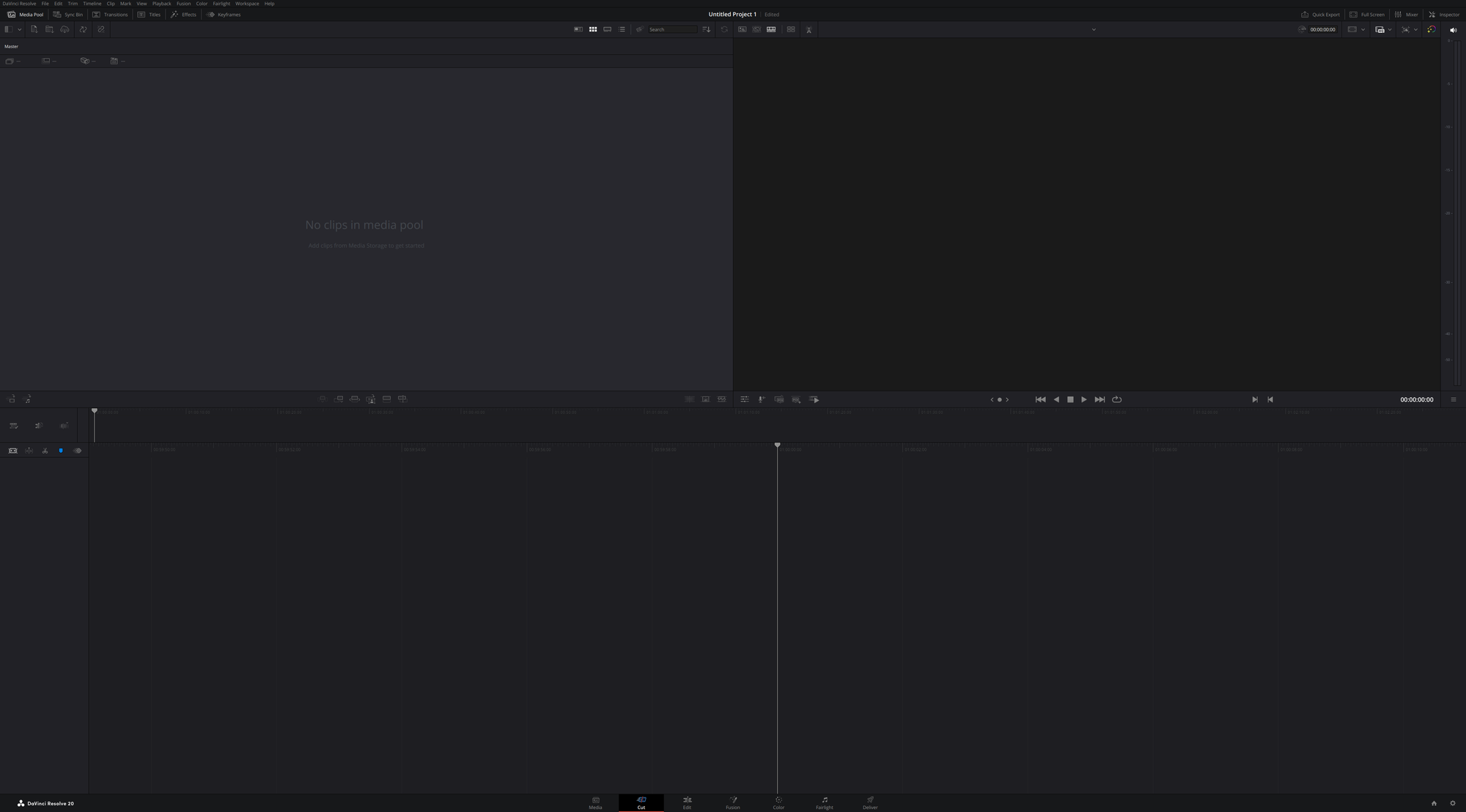
Continuing to Share this Journey
This post was meant as an introduction to why I'm making this switch and how I'm doing it (at least how I'm doing it at this moment). Rebasing my entire workflow, which I've built up over the last decade+, is by no means an easy task. It's going to be an ongoing process.
Given the effort it's going to take, you may be left asking if it's really worth it. For many, the answer may very well be no, but for me, the answer is an astounding yes. This journey isn't just about saving a few hundred dollars a year (though that's certainly a nice perk). It's about taking back control of my personal computing. By making these changes, I'm moving a bit further away from the nightmare that is big tech and putting myself back in control of my devices. There's certainly a lot more I could do on this front, but this is a great start.
The importance of free and open computing is something that I'm passionate about, and I hope that if you've read this far, I've at least given you something to think about. Maybe I've even convinced you to give some of these alternatives a try yourself!
One area where the open-source community is severely lacking is people building pro-level photography workflows using free and open-source technologies. Or, perhaps, it's better to say that it's lacking people sharing how they're doing this. I believe that this is one of the biggest blockers to getting more photographers on these tools and, hence, having the user share to improve them even further. As such, I intend to continue to share my journey here on this blog.
To this end, I've created a new section of this blog dedicated to Open Source Photography. My intention with this is to not only share my journey into this space, but to hopefully help others with their own journey. I suspect that this will become a big part of this blog over time (but don't worry, the normal content will still be here too)!
Open to Suggestions
As you can probably tell, I'm still early in my quest to build a completely free and open-source photography workflow. There's plenty that I still don't have figured out!
I'm sure there are others out there that are further along in this process than I am, and I'd love to hear from you all! Please feel free to reach out to me with any insights or suggestions that you may have!
You can always comment on these posts, but you can also hit me up on Mastodon or shoot me an email at: adam [at] adamthompsonphoto.com. I'd love to build a community of passionate open-source photographers!




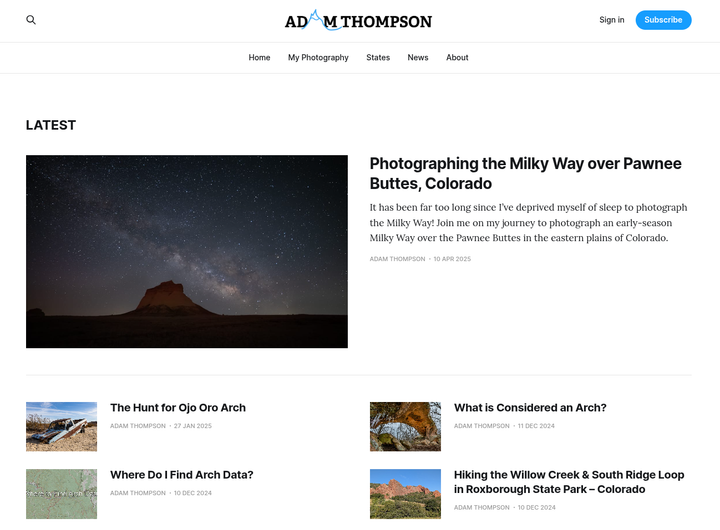
Comments ()